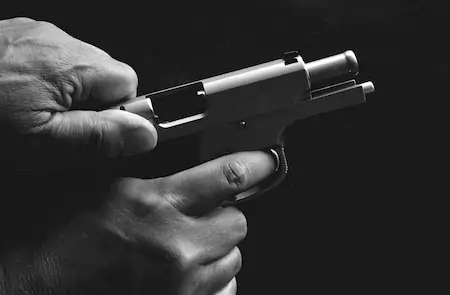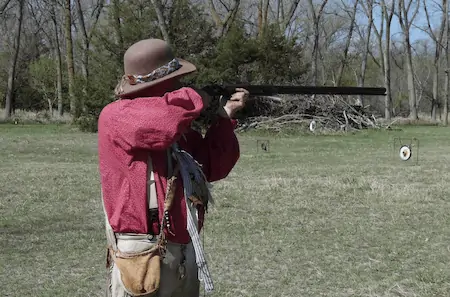To be a successful hunter, the very first thing that you need to learn is to shoot with your firearm the right way with accuracy.
It is actually a gradual process that you master over the years. But the whole process starts with the knowledge of the firearm’s features and functions, where knowing the action styles is a significant part.
So, what are the two basic styles of firearm actions then?
In this article, we will discuss those two types in detail, along with their nature and necessity in different hunting situations.
Table of Contents
Why Should You Learn about Firearm Actions?
While being a hunter or shooter, you can’t think of going ahead without learning about firearm actions.
It is a combination of knowledge about loading, unloading, shooting, and ejecting the ammunition of your firearm. It helps you to understand how your gun usually works and what exactly you can expect from it.
Once you know about these actions and you know how to apply this knowledge in a real-life hunting scenario, you are already ahead in the race of hunting.
Two Basic Styles of Firearm Actions
Two basic styles of firearm actions are- single shot and repeating style. There are different types of firearms, and they function differently.
In some of them, you will find there is only a single-shot action option, and in some others, you can enjoy repeated actions of bullets one by one.
What is Single Shot Action?
Single-shot is a typical action style that most of the firearms will offer you. It means you have to reload the gun every time you are going to take a shot.
It is the most common action style that most hunters use while hunting their desired animal.
The firearms which are primarily known for single-shot style are rifle, revolver, and pistol.
In these firearms, the hammer needs to be fixed manually every time before you take a shot. Here the trigger helps to initiate the strike through the hammer.
There is no magazine in single-shot firearms, and the cartridge needs to be removed after every shot. Before you fire your gun back, the action needs to be closed as the cartridge is expanded.
However, there is a slight difference between a revolver and a pistol in setting up for firing.
In pistols, you need to set the firing function once before you take the first shot, and after that, there is nothing to worry about in the subsequent shots.
Here the action of the slide will be responsible for the following ones. Single shots are known by different names such as rolling block, falling block, bolt action, trapdoor, etc.
Though the development of firearms as we see it today has reached this point with single-shot arms being present out there.
With the discovery of metallic cartridges, things started to go in an upward direction. But the necessity of single-shot guns is always there.
This action style is preferable mainly for those hunters who have mastered their skill so that they are confident enough to beat up the target with just a shot.
And, this is something every shooter wants to achieve in their shooting or hunting career.
So, here is a quick summary about single-shot action:
- Single-shot firearms don’t come with magazines.
- They will have only one cartridge at a time.
- Once you are done shooting, the cartridge needs to be removed. You can replace the cartridge if you want to make it more convenient.
- Before you fire your shot again, you need to fix the action style once you have expanded the cartridge.
- Examples of single-shot firearms are pistol, rifle, and shotgun.
- There are different types of single-shot actions named as: flobert, martini, break open, falling block, tin up, rolling block, bolt action, etc.
What is Repeating Style?
Repeating style action came into existence with the advantage of using extra cartridges into the firearm. These cartridges are also known as extra barrels, shotshells, and even cylinders.
This repetitive firing style is considered the new age trend, where single-shot firearms are often taken as a thing of the past.
However, repeating style means once you load the gun, you don’t have to reload it back after every shot.
That means you can enjoy shooting on a target continuously until and unless you run out of bullets into your cartridge. It is the opposite action style compared to single-shot firearms.
This kind of action style is primarily found in rifles along with some other forms of firearms.
And, this kind of firearm usually comes with a spring-loaded cartridge or tubular along with a magazine box with the system of storing a metal into it.
Moreover, you will also find extra magazines to carry powder and a ball in these repeaters.
When it comes to wars and hunting rough, this kind of repeating action style is preferable. It’s also recommended for those who haven’t mastered their shot yet to hunt within a single try.
So, when you have repeating-style firearms, you have the advantage of making a successful hunt or destroy the enemy with confidence.
Indeed, warfare is a critical situation where you must have good shooting skills. Just because your firearm supports repeated actions of bullets one by one without any obstacles of reloading, that doesn’t mean you are spared from practicing and mastering the skill.
In this way, you will be wasting a good amount of bullets without making any successful shots, and you will lose your chances to defend yourself in the process.
So, the success still depends on how much you have practiced and mastered the art of shooting. It goes the same way when it comes to hunting the target animal as well.
From the point of holding your gun to aiming, sighting, firing, and even making it perfect, all these skills are a must for a successful hunt or warfare victory.
So, here comes the summary of repeating action style-
- The repeating style comes with a spring-loaded cartridge or tubular, with a magazine box with the space to hold a metal.
- This kind of action style is mainly seen in firearms like rifles.
- In this style, the cartridge directs the action to breach by the chamber, level, pump, or semi-automatic system.
- Most of these repeating-style firearms have extra magazines for storing powder and balls.
- It is a preferred style for those who need multiple shots at the same time while hunting or shooting at enemies in warfare.
How to Make Your Shot Perfect?
So, as you already got to know about two different action styles of firearms, now we will be sharing some tips with you to make your aim and shot perfect.
- Choose the right firearm and necessary tools before you make an aim to shoot the first shot.
- Fixing the right shooting stance and distance before handling your forearms for an accurate shot is pretty much mandatory. Your arms shouldn’t be locked rather fully extended and stretched, where your shoulders need to be in a relaxing mood.
On the other hand, your feet should be apart from each other based on hips width. When it comes to your torso, lean it a bit forward along with bending your waist slightly.
- One of the most important things to learn to make your aim and shot right is to hold your grip tight. Because when you are shooting, the firearm has an opposite reaction back to your body, so if you don’t grab it the right way, you will most probably make an unsuccessful attempt at the target.
- Try to adjust the sight until and unless it seems right, and don’t forget to align the front sight visually. Make sure that the top of the rear and front sight both are at the same level. Once you find them alighted, make an aim on the target and shoot.
- Whether you practice it at home or in any training ground, try to ensure safety all around so that no accident happens.
- The more you practice, the more you master your skills in everything. When it comes to making perfect shots, the rule is the same. If you keep practicing with firearms with repeating style, with time, you will reach a point when you can make a perfect shot within a single shot.
Final Words
It is pretty nerve-wracking to hold the gun at the initial stages of your firing career, but with time and regular practice, you gain that confidence quickly.
Knowing about the two basic styles of firearm actions is where you start your theoretical journey to learn about firing that you will turn into reality.
Once you get these ideas clear, you gradually become familiar with all the other necessary parts of shooting.
We hope our article works as an excellent starter for you in this field and don’t stop until you become a successful hunter or shooter.




